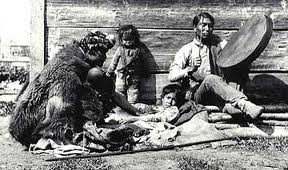Tsimshian
The Tsimshian languages are Gitksan and Nisga'a. These speakers occupied coastal and interior regions, specifically the valleys of the Nass and Skeena rivers.
Tsimshian speakers comprised four principal clans. Each clan, founded by a heroic ancestor, was sub-divided into family branches. Villages were composed of several houses and people who shared matrilineal lineage resided together in a house. Family names were property in the same manner as the house itself. Totem poles, masks, house facades, feast dishes, canoes, storage boxes, helmets, cradles, and chamber pots reflected clan ownership in their decorative designs.
 A hereditary chief governed each village. He served both a ceremonial and social function, but ultimately he had very little political power. Instead, he represented the prestige and wealth of his village. Gift giving feasts or potlatch reflected the spiritual powers associated with the chief and his family. The right to dance the dances and sing the songs bestowed by supernatural ancestors had to be affirmed and acted out before a public gathering. The chief controlled the time, purpose, and organisation of a potlatch. Winter ceremonial dances represented the forces that controlled the earth. The chief controlled the winter potlatch and in doing so held influence over these spirits. The chief was accredited with the ability to mediate with spiritual powers. Competitive games were also part of the potlatch celebration. Wrestling, weight lifting, tug of war, foot races, and gambling were opportunities for individuals to gain recognition from the chief.
A hereditary chief governed each village. He served both a ceremonial and social function, but ultimately he had very little political power. Instead, he represented the prestige and wealth of his village. Gift giving feasts or potlatch reflected the spiritual powers associated with the chief and his family. The right to dance the dances and sing the songs bestowed by supernatural ancestors had to be affirmed and acted out before a public gathering. The chief controlled the time, purpose, and organisation of a potlatch. Winter ceremonial dances represented the forces that controlled the earth. The chief controlled the winter potlatch and in doing so held influence over these spirits. The chief was accredited with the ability to mediate with spiritual powers. Competitive games were also part of the potlatch celebration. Wrestling, weight lifting, tug of war, foot races, and gambling were opportunities for individuals to gain recognition from the chief.
The religious system of the Tsimshian was based upon supernatural forces that controlled the environment. People tried to cultivate a collaborative relationship with these forces and the winter celebrations continued for several months as a means of thanksgiving and of appeasing the spirit world. The potlatch brought the powers of the supernatural world to the Tsimshian world.